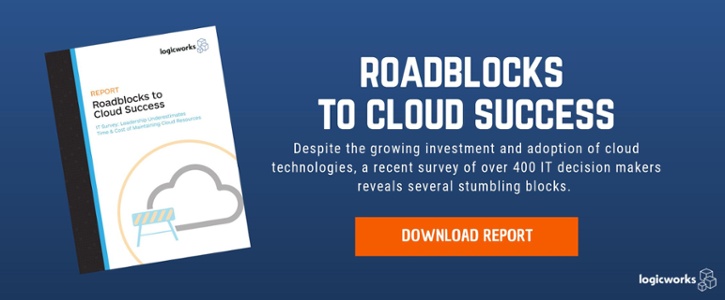Despite the clear advantages of cloud, enterprises can be skittish about getting “trapped” in a public cloud vendor. But unfortunately, this may prevent them from achieving success in the cloud, a new survey finds.
According to Logicworks survey by Wakefield Research, seventy-eight percent (78%) of IT decision makers believe that concerns about vendor lock-in prevent their organization from maximizing the benefits of cloud resources. This means that the majority of IT leaders consciously choose not to fully invest in cloud because they value long-term vendor flexibility over long-term cloud success.
The Cost of Avoiding Lock-In
The study confirms reports by Gartner, Fortune and others that cite IT executives who believe the overwhelming market dominance of public cloud players like Amazon is a negative; to combat this, these companies use core services like Amazon EC2 and S3 but stay away from “higher level” managed services like databases and orchestration tools. The perception is that if you use AWS’ basic services and build your own management tools, you can pick up and leave Amazon more easily.
The trouble is that there is a cost to this choice. The benefit of the public cloud is not just outsourced compute and storage. It is that public cloud providers like AWS have spent the last 10 years building advanced, scalable infrastructure services—and they release hundreds of updates to these services every year. You do not have to build your own version of these services, you never have to upgrade your cloud to get these new features, you do not have to patch them or version them. They just show up.
Also, if you build your own queuing, notification, networking tools, etc. that you can get from AWS, you spend the same amount of time — if not more — upfront building or re-architecting your own tools. Then you have to manage those tools, update them, and improve them over time.
The other option is to run “multicloud” — use two or more public cloud vendors and/or PaaS providers, so that you can leave one or the other at any time. While only a small number of enterprises currently take this approach, it seems to be rising in popularity. The problem with this approach is that cloud vendors have no incentive to make the seamless transition of data between clouds possible, and many thought leaders claim the “interoperable cloud” is a dream. In reality, multicloud can be complicated, messy, and result in applications built to the lowest common (cloud) denominator.
Alternative Paths to Cloud Success
Is there a way to balance vendor lock-in fears with manageability? To avoid vendor-lock in while still reducing the complexity of IT management? The answer is not about keeping one foot out of the cloud, but about fully embracing a new way of managing IT. The real challenge in migrating to any IaaS platform is not the technology itself but the governance models, cost control measures and the processes your systems and development teams use to work together. The hard part is evolving the role of central IT as not just purchaser and governance body, but an engine of continuous development and change.
The cloud gives IT teams an opportunity to work with infrastructure as code, which means that infrastructure can be versioned, tested, repeatable, and centrally managed. Central IT can develop an infrastructure system, create a template from it, and establish guardrails for the evolution of that template by multiple business units. Usually this takes the form of a security playbook or service catalog, where users can launch resources from pre-formulated templates in which security best practices are embedded. This follows the service-oriented IT model where central IT becomes the service provider or PaaS platform through which IaaS is ingested.
When you implement templatization (AWS CloudFormation, Terraform) and configuration management, you build a set of management standards that will serve you in every IaaS platform. You just have a JSON file that controls virtual resources and could theoretically be configured to build any cloud resource with any vendor. Any work you do on this front will make it easier to manage or migrate in or out of your cloud.
Why is central IT the key player in preventing vendor lock-in? It is all about defining standards that transcend the boundaries of platforms or cloud vendors. Getting the platform wrong can cost you three months of work. Getting the standards right will serve you for years to come. If you ever need to migrate out of your primary cloud provider, you will have a central entity that knows where workloads live and can intelligently recreate practices on a second platform.
The Future of Vendor Lock-In
Vendor lock-in will never be absent from IT. IT management is too complex; it will always be easier/more cost-effective on some level for organization to use a vendor’s tools or resources than to build their own. Vendors are vendors — they want you to stick around. The key is not to defend your organization by avoiding cloud, but by rethinking the way you manage IT all together.
In the end, intelligent cloud management allows you to maximize the benefits of the cloud without getting stuck in one vendor. When you get the people and process right, changing the technology is not so daunting.
Logicworks is an enterprise cloud automation and managed services provider with 23 years of experience transforming enterprise IT. Contact us to learn more about our managed cloud solutions.


